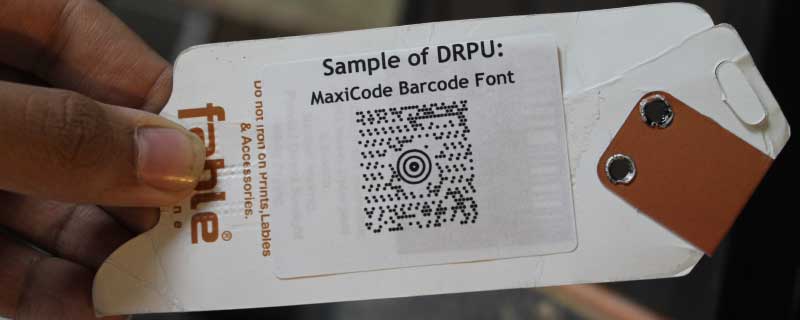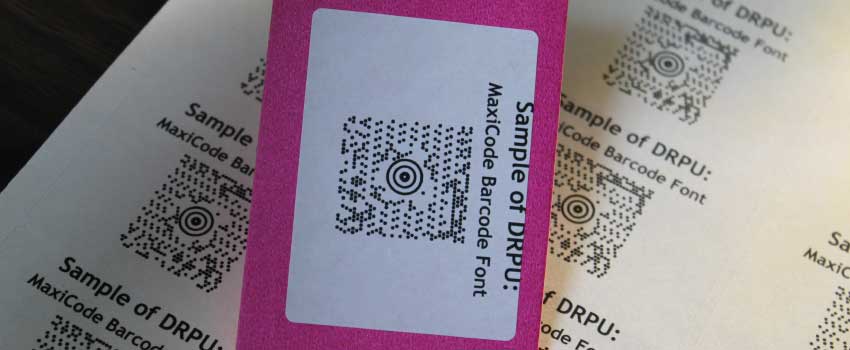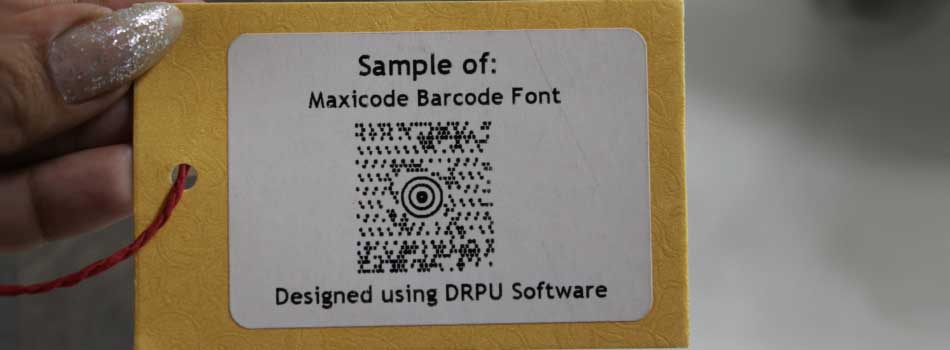Related Points of MaxiCode Barcode:-
-
MaxiCode is a two-dimensional (2D) matrix barcode that was developed by United Parcel Service (UPS) in 1992. It was designed for high-speed, automated sorting and tracking of packages and parcels. MaxiCode is a fixed-size, circular barcode that consists of a central bullseye pattern surrounded by a series of concentric rings. It can encode up to 93 alphanumeric characters, including letters, numbers, and symbols.
-
One of the key advantages of MaxiCode is its high information density. It can encode up to 93 alphanumeric characters in a relatively small amount of space, which makes it ideal for use on small packages and labels. Additionally, MaxiCode is highly resistant to damage and can still be read even if a portion of the barcode is missing or damaged.
-
One limitation of MaxiCode is that it requires a special type of barcode scanner, namely a 2D imager, in order to be read reliably and accurately. This means that companies that wish to use MaxiCode barcode may need to invest in new scanning equipment or upgrade their existing equipment in order to support this barcode format.
-
MaxiCode is designed to be read by a special type of barcode scanner called a 2D imager. These scanners use image-capture technology to take a picture of the barcode and then use software to decode the information encoded within it. MaxiCode can also be read by some laser scanners and camera-based scanners, but these require a clear, unobstructed view of the barcode and may not be as reliable as 2D imagers.
-
Another advantage of MaxiCode is its ability to encode multiple types of information within a single barcode. For example, MaxiCode can encode the destination address, tracking number, and other relevant information for a package. This makes it easy for shipping companies to track packages and manage their logistics operations more efficiently.
-
MaxiCode also includes built-in error correction capabilities, which helps to ensure that the barcode can be read even if it is partially obscured or damaged. This helps to improve the reliability and accuracy of the information encoded within the barcode, which is particularly important in applications where accuracy is critical.
-
MaxiCode is widely used in the shipping and logistics industry, particularly by UPS and other courier services. It is used to track packages and parcels throughout the shipping process, from the time they are picked up at the sender's location to the time they are delivered to the recipient. MaxiCode can also be used in other applications, such as inventory management, asset tracking, and ticketing.
Overall, MaxiCode is a powerful and versatile barcode format that is well-suited to a wide range of applications in the shipping, logistics, and transportation industries. Its high information density, built-in error correction capabilities, and ability to encode multiple types of information within a single barcode make it an attractive choice for companies looking to streamline their operations and improve their efficiency.
MaxiCode Barcode is Different from Other Types of Barcodes
A MaxiCode barcode is a two-dimensional (2D) barcode that is different from other types of barcodes, such as one-dimensional (1D) barcodes, in several ways. Here are some of the key differences:
-
2D Capability:
MaxiCode barcodes are 2D barcodes, which means they can store much more data than 1D barcodes. This is because 2D barcodes can store data both horizontally and vertically, whereas 1D barcodes only store data horizontally. As a result, MaxiCode barcodes can hold up to 93 characters of information, while 1D barcodes are typically limited to 20-30 characters.
-
Specific Application:
MaxiCode barcodes were specifically designed for use in the logistics and transportation industry, where they are used to track and manage packages, and shipments. As a result, they have features that are tailored to the needs of this industry, such as support for international shipping codes and the ability to store multiple pieces of information in a single barcode.
-
Security Features:
MaxiCode barcodes also include several security features, such as encryption and digital signatures, that can help to prevent unauthorized access to the data stored in the barcode.
-
Hexagonal Shape:
MaxiCode barcodes are hexagonal in shape, which makes them stand out from other types of barcodes symbologies. This shape is designed to help barcode readers quickly and easily locate and read the barcode, even if it is partially obscured or damaged.
-
Error Correction:
MaxiCode barcodes include a built-in error correction algorithm that helps to ensure that the barcode can still be read even if it is partially damaged or obscured. This is particularly important in applications where the barcode is likely to be exposed to harsh environments or rough handling.
In summary, the purpose of using QR Code Barcodes is to provide quick and easy access to information for users. QR Codes are versatile, customizable, and offer a high level of security, making them an ideal solution for a wide range of industries and applications.
Download and Install Barcode Software
Purpose of Using a MaxiCode Barcode
The purpose of using a MaxiCode barcode is to enable efficient and accurate tracking and management of packages, shipments, and other goods in the logistics and transportation industry.

Here are some of the key benefits of using MaxiCode barcodes in the logistics and transportation industry:
-
Improved Efficiency:
MaxiCode barcodes can be quickly and easily scanned by barcode readers, which helps to improve efficiency and reduce the amount of time and effort required to track and manage packages and shipments. This can help companies to save time and money and improve their overall productivity.
-
Increased Accuracy:
MaxiCode barcodes are designed to be highly accurate, even in challenging environments. Their built-in error correction algorithm helps to ensure that the barcode can still be read even if it is partially damaged or obscured. This helps to reduce errors and improve the accuracy of package tracking and management.
-
Enhanced Security:
MaxiCode barcodes include several security features, such as encryption and digital signatures, that can help to prevent unauthorized access to the data stored in the barcode. This helps to protect sensitive information and prevent fraud and other types of security breaches.
-
Support for International Shipping Codes:
MaxiCode barcodes can store multiple pieces of information in a single barcode, including international shipping codes. This makes them an ideal choice for companies that need to manage shipments that cross international borders.
-
Scalability:
MaxiCode barcodes can be scaled up or down to meet the needs of different applications. This makes them a flexible and adaptable solution for companies that need to track and manage packages and shipments of varying sizes and types.
Overall, the purpose of using MaxiCode barcodes is to enable companies in the logistics and transportation industry to improve efficiency, accuracy, and security in their package tracking and management operations. By providing a high level of data capacity, error correction, and security, MaxiCode barcodes can help these companies to save time and money, reduce errors, and improve their overall productivity and profitability.
Industries that are Commonly uses MaxiCode Barcode
MaxiCode barcodes are commonly used in industries that require high-speed, automated data processing, tracking and logistics operations, and supply chain management. These industries include:
-
Transportation and logistics:
MaxiCode barcodes are widely used in the transportation and logistics industry for tracking and tracing packages, parcels, and shipments. These barcodes enable efficient tracking and tracing of products from the manufacturer to the end consumer.
-
Manufacturing:
MaxiCode barcodes are used in manufacturing facilities to track products, parts, and inventory. The barcode can hold a significant amount of data, including manufacturing details such as part numbers, lot numbers, and production dates.
-
Retail:
Retailers use MaxiCode barcodes for inventory management and product tracking. The barcode can store a variety of information about the product, such as the SKU number, product description, and retail price.
-
Healthcare:
MaxiCode barcodes are used in the healthcare industry for patient identification, tracking, and medication administration. The barcode can hold patient information, such as medical history, allergies, and medication details, and enable healthcare professionals to access this information quickly and accurately.
-
Postal services:
MaxiCode barcodes are used in the postal service industry for sorting and tracking mail and packages. These barcodes enable efficient and accurate delivery of mail and packages to the intended recipients.
-
Government:
The government uses MaxiCode barcodes for tracking and managing items such as equipment, assets, and inventory. The barcode can hold data such as item descriptions, serial numbers, and location information.
-
Warehouse and distribution:
MaxiCode barcodes are used in warehouse and distribution operations for inventory management and tracking. The barcode can hold data such as product descriptions, quantities, and locations, enabling efficient and accurate management of warehouse operations.
-
Automotive:
The automotive industry uses MaxiCode barcodes for tracking and managing parts and inventory. The barcode can hold data such as part numbers, production dates, and manufacturing details, enabling efficient management of automotive parts and inventory.
Overall, MaxiCode barcodes are used in a wide range of industries that require efficient and accurate tracking, management, and processing of data. These barcodes are highly versatile and can store a significant amount of data, making them an ideal choice for industries that require efficient and reliable data processing and management.
Encoding Information in MaxiCode Barcode
MaxiCode barcodes can encode a variety of information, including package or shipment identification data, destination and origin addresses, and additional shipping or routing information. Here is a more detailed explanation of the different types of information that can be encoded in a MaxiCode barcode:

-
Package or Shipment Identification Data:
MaxiCode barcodes can encode package identification data, such as a unique tracking number, to enable package tracking and management. This information can be used to identify individual packages or shipments and track their movements through the logistics and transportation network.
-
Destination and Origin Addresses:
MaxiCode barcodes can encode destination and origin addresses of the product delivery to help ensure that packages and shipments are delivered to the correct location. This information can include street addresses, city and state information, and postal codes.
-
Additional Shipping or Routing Information:
MaxiCode barcodes can encode additional shipping or routing information to help ensure that packages and shipments are delivered efficiently and on time. This information can include the name and location of the shipping and receiving facilities, carrier information, and other details related to the transportation of the package or shipment.
-
International Shipping Codes:
MaxiCode barcodes can also encode international shipping codes, such as the International Air Transport Association (IATA) airport code and the International Maritime Organization (IMO) port code. This information can help to facilitate international shipping and ensure that packages and shipments are transported securely across international borders.
MaxiCode barcodes are designed to provide a high level of data capacity, which enables them to store large amounts of information in a compact space. The maximum data capacity of a MaxiCode barcode is 93 characters, which includes a 16-character header, a 6-character postal code, and up to 71 data characters.
The structure of a MaxiCode barcode is divided into several sections, including the header, mode, postal code, data field, and error correction code. The header contains information about the format and data structure of the barcode, while the mode section determines the type of information that is encoded in the barcode. The postal code section contains information about the destination postal code, and the data field section contains the actual data that is being encoded. The error correction code is used to ensure the integrity of the data and to enable the barcode to be read even if it is partially damaged or obscured.
Posted By: 👤 Techsavvy
|Updated On: 📅
